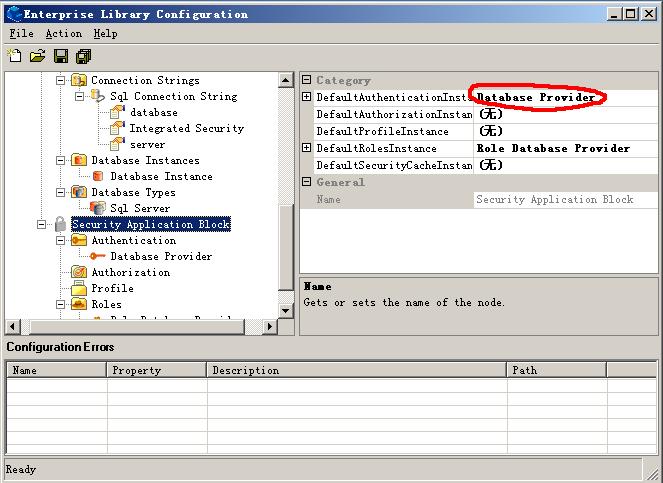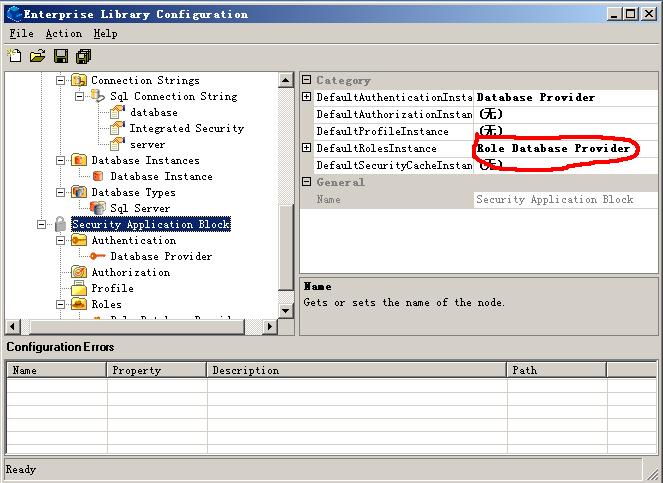Enterprise Library Step By Step系列(五):安全应用程序块——入门篇
一. 安全应用程序块概述:
安全应用程序块通过一个或多个安全机制,帮助开发人员在应用程序中实现通用的安全相关任务。
需要提高扩展性,以便在不改变应用程序代码的情况下更改认证或授权方式。
提供了以下几个方面的功能:
1.认证
2.授权
3.角色管理
4.Profile管理
二. 几个重要的概念:
1. Credential(令牌)
2. Identity(身份)
3. Principal(主体特征)
三. 使用三部曲:
在进行使用前请确保项目中有App.config或Web.config文件,并且需要数据库中有相关的表和存储过程,具体可参见数据库EntLibQuickStarts(Enterprise Library的示例库)。
1.定义配置文件:
(1)运行Enterprise Library Configuration 配置工具,打开项目中的配置文件;
(2)右击Application,选择New | Security Application Block,创建一个安全应用程序块;
(3)在Security Application Block | Authentication 节点上右击,选择 New | Database Authentication Provider,创建一个数据库认证Provider;
(4)根据在数据访问应用程序块中所讲的,设置数据库的连接字符串;
(5)右击Cryptography Application Block | Hash Providers,选择New | Hash Algorithm Provider,创建一个加密Provider,并设置SaltEnabled为True;
(6)选择Security Application Block | Authentication | Database Provider,设置 Database 属性为 Database Instance, 并且设置 HashProvider 属性为SHA1Managed;
(7)选择Security Application Block,设置它的DefaultAuthenticationInstance为Database Provider;
(8)选择File | Save All保存全部。
至此,关于认证部分的配置已经做完。仅仅有这些还不够,我们还要进行设置角色。
(9)选择Security Application Block,右击Roles,选择New | Role Database Provider创建一个角色的数据库Provider;
(10)设置Database属性为Database Instance;
(11)选择Security Application Block节点,设置DefaultRolesInstance,为Role
(12)保存全部File | Save All。
至此,所有的配置文件的工作已经做完。最后别忘了,做拷贝目录
 copy "$(ProjectDir)\*.config" "$(TargetDir)"
copy "$(ProjectDir)\*.config" "$(TargetDir)"
2.创建Security Provider实例:
 IAuthenticationProvider authprovider;
IAuthenticationProvider authprovider;2
 authprovider = AuthenticationFactory.GetAuthenticationProvider();
authprovider = AuthenticationFactory.GetAuthenticationProvider();3.执行Security Provider命令:
 public static bool Authenticate(string username, string password)
public static bool Authenticate(string username, string password)2
 {
{3
 bool authenticated = false;
bool authenticated = false;4

5

6
 NamePasswordCredential credentials;
NamePasswordCredential credentials;7
 credentials = new NamePasswordCredential(username, password);
credentials = new NamePasswordCredential(username, password);8

9
 IAuthenticationProvider authprovider;
IAuthenticationProvider authprovider;10
 authprovider = AuthenticationFactory.GetAuthenticationProvider();
authprovider = AuthenticationFactory.GetAuthenticationProvider();11

12
 IIdentity identity;
IIdentity identity;13
 authenticated = authprovider.Authenticate(credentials, out identity);
authenticated = authprovider.Authenticate(credentials, out identity);14

15
 if (!authenticated)
if (!authenticated)16
 {
{17
 throw new SecurityException("Invalid username or password.");
throw new SecurityException("Invalid username or password.");18
 }
}19

20

21

22
 IRolesProvider rolesprovider;
IRolesProvider rolesprovider;23
 rolesprovider = RolesFactory.GetRolesProvider();
rolesprovider = RolesFactory.GetRolesProvider();24

25
 IPrincipal principal;
IPrincipal principal;26
 principal = rolesprovider.GetRoles(identity);
principal = rolesprovider.GetRoles(identity);27

28
 // Place user's principal on the thread
// Place user's principal on the thread29
 Thread.CurrentPrincipal = principal;
Thread.CurrentPrincipal = principal;30

31
 return authenticated;
return authenticated;32
 }
}入门篇就到这里了,安全应用程序块内容比较多,所以有些步骤里面我没有截图,请大家谅解。在进阶篇里面,我会分别介绍认证,授权(包括授权规则),角色,个性化服务,以及严格的帐号管理策略,Security Cache,包括第三方的基于数据库角色授权的插件等。
Worktile,新一代简单好用、体验极致的团队协同、项目管理工具,让你和你的团队随时随地一起工作。完全免费,现在就去了解一下吧。
https://worktile.com











